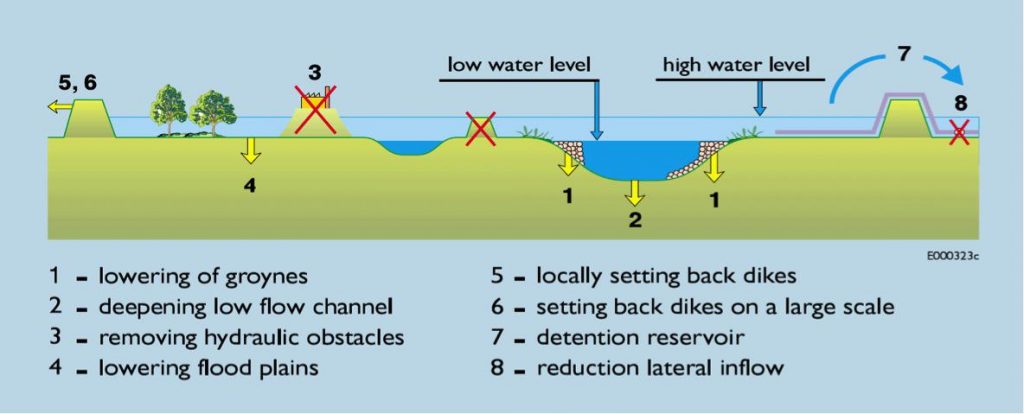2.3.1 Building Blocks for River Intervention: Measures for River Interventions
Course subject(s)
Module 2. Engineering the River
Room for the river is based on a strategy of working with nature.
Working-with-nature is an approach in which optimal use is made of natural dynamics such as wind, water, sediment and vegetation and may lead to a positive effect on nature. Similar concepts to working with nature are ‘building with nature’, ‘eco-engineering’, ‘ecological enhancement’ and other.
Working with Nature solutions contribute to multifunctional land use, such as nature development, flood risk management, fresh water supply, fisheries, recreation and infrastructure.
The use of natural dynamics leads to solutions which are more adaptable in anticipating to (uncertain) changing, natural or socio-economic conditions. On the other hand, natural dynamics are inherently less predictable due to variability of weather conditions but also the complexity of ecological and morphological processes. Therefore working with nature solutions require adaptive pathways for decision-making and an adaptive governance approach to facilitate implementation and maintenance of the working-with-nature solutions.
Adaptive pathways include the use of multiple scenarios on future socio-economic and physical developments (e.g. climate change or land-use) and possible actions. An adaptive governance approach includes principles of continuous and collective learning to include new insights and knowledge, a participatory monitoring program, wide participation of stakeholders, and a continuous process of reflexive decision-making. This is contrary to more conventional approaches where, after implementation, projects are finished. The dynamic and unpredictable character of working with nature solutions, requires a continuous process of decision-making.
In the next video, professor Rutten will explain what factors are taken into account when viewing the river from an engineering perspective. Furthermore, the intervention measures that were used in Room for the river to deal with the intricate dynamics are introduced.
In the video, building blocks were mentioned. Below an extended schematic explanation can be found of the measures that were adopted in the Room for the river program.
Schematic
The room for the river approach consists of a number of separately applicable measures. Eight measures of the room for the river approach are presented in the figure below.

Elucidation
- Groynes stabilise the location of the river and ensure its correct depth. However, in a high water situation, groynes may obstruct the flow to the river. Groynes reduce the inundation time duration, increasing floodplain resilience.
- Excavating/deepening the surface of the riverbed creates more room for the river. Eco-engineering solutions can produce natural channel designs.
- If feasible, removing or modifying obstacles in the riverbed will increase the floodplain discharge capacity.
- Lowering/excavating part of the floodplain increases room for the river in high water situations
- Relocating a dike inland widens the floodplain and increases room for the river
- Relocating a dike inland on a large scale will widen the floodplain on a larger scale and will create more room for the river. The dike on the riverside of a polder is lowered and relocated inland. This creates space for excess flows in extreme high water situations. *The difference between depoldering and dike relocation is that depoldering is usually about agricultural land, that had formerly been claimed from the river, which is then given back as flowspace.
- Reducing the lateral inflow by measures in the field of land use.
- Retention will reduce peak water flows by storing the water upstream. Runoff production can be reduced by for example reforestation.Two more possible measures, which are not part of figure 1, are:
- Creating a by-pass or a high water channel. This is a dike area branching off from the main river to discharge some of the water via a separate route.
- A proper land use planning within the floodplain, preventing the increase of flood exposition in the future.
Countries including the United States, Australia, United Kingdom, Denmark, Germany and countries in South East Asia conducted projects similar to the room forthe river concept in the Netherlands. The origin of room for the river concept can be manifold: the projects are ecological, flood safety or climate change driven. Anotherdriver for realizing more room for the river is the worldwide attention for integrated river basin management (Verkerk & Van Buuren, 2013).
An important trigger of implementing the room for the river approach is the occurrence of (near) disasters. However, general trends in society such as the democratization of society and emancipation of citizens and stakeholders groups and the trend towards sustainability and quality of life have also affect the decision toimplement the room for the river approach (Verkerk & Van Buuren, 2013).

Room for Rivers: Perspectives on River Basin Management by TU Delft OpenCourseWare is licensed under a Creative Commons Attribution-NonCommercial-ShareAlike 4.0 International License.
Based on a work at https://online-learning.tudelft.nl/courses/room-for-rivers-perspectives-on-river-basin-management/.



